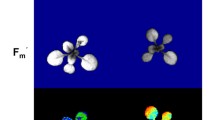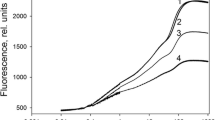Summary
The genephysiological and developmental basis of “Dauermodifications” (DM) have still not been explained. In particular definite evidence for DM in plastids is lacking up to now. Moreover no attention has been paid to the connections with the problem of quantitative gene effects. For that reason mutants of the nuclear gene ch in Arabidopsis thaliana (L.) Heynh., quantitatively defective in chlorophyll b were tested during seven generations under continuous yellow radiation (λ < 550 nm) expecting DM.
The following results were obtained: 1) The main effects of the homoalleles ch +, ch 1 and ch 2 on the reactions of chlorophyll transformation, especially on chlorophyll b-synthesis, cannot be modified permanently. 2) DM in certain accessory effects of the gene ch, i.e. carotinoid content (CC), apparent radiation energy use (EAG) and net assimilation rate (NAR) were induced by the applied radiation. These modifications are quantitative and cannot be restituted in the following generation after return to normal light.
The induced DM affects phenotypic characters of the plastids which may result from biochemical regulation modified at the level of translation. The effects of multiple interactions between the allelic condition of the gene ch, the rest of the nuclear genes, the carriers of the extrachromosomal gene information, and the inducing environmental factor must be considered.
Zusammenfassung
Die genphysiologischen Grundlagen der Entstehung von Dauermodifikationen (DM) sind noch weitgehend ungeklärt. Insbesondere fehlen bisher eindeutige Beweise von DM an Plastidenphänen. Darüberhinaus wurde ihr Zusammenhang mit dem Problem der quantitativen Genwirkung nicht beachtet. Quantitative Chlorophyll b-Defektmutanten des Kerngens ch von Arabidopsis thaliana (L.) Heynh. wurden daher einem über 7 Generationen dauernden Test zur Auslösung von DM durch Gelblicht (λ > 550 nm) unterworfen.
Hierbei wurden folgende Ergebnisse erhalten:
-
1.
Die Hauptwirkung der Allele ch +, ch 1 und ch 2 auf die Chlorophyllumwandlungsreaktionen insbesondere die Chlorophyll b-Synthese kann durch Gelblicht nicht dauermodifiziert werden.
-
2.
In bestimmten Nebenwirkungen des ch-Gens (CC, EAG und NAR) werden abhängig vom Allelzustand des Kerngens durch die verwendete Strahlung DM ausgelöst. Sie bestehen in quantitativen Merkmalsänderungen, die auch nach Rückführung in normales Licht in der darauffolgenden Generation nicht restituiert werden.
Die erhaltenen DM betreffen Plastidenphäne, die vermutlich durch biochemische Regulationsänderungen auf der Ebene der Translation entstehen. Hierbei müssen die mehrfachen Interaktionen zwischen dem Allelzustand des ch-Locus, dem Restgenom des Kerns und den extrachromosomalen Erbinformationsträgern sowie dem auslösenden Umweltfaktor beachtet werden.
Similar content being viewed by others
Literatur
Allard, R. W., Adams, J.: Populationstudies in predominantly self-pollinating species. XIII. Intergenotypic competition and population structure in barley and wheat. Amer. Natural. 103, 621–645 (1969).
Björkman, O.: Further Studies on Differentiation of Photosynthetic Properties in Sun and Shade Ecotypes of Solidago virgaurea. Physiologia plantarum 21, 8–99 (1968).
Björkman, O., Gauhl, E.: Carboxydismutase Activity in Plants with and without β-Carboxylation Photosynthesis. Planta 88, 197–203 (1969).
Butterfaß, Th.: Wachstums- und Entwicklungsphysiologie der Pflanze. Heidelberg: Quelle und Meyer 1970.
Floor, E.: Interaction of Morphogenetic Genes of Bacteriophage T 4. J. Mol. Biol. 47, 293–306 (1970).
Hanson, W. D.: Genotypic Stability. Theoret. Appl. Genet. 40, 226–231 (1970).
Hayward, M. D., Nsowah, G. F.: The genetic organisation of natural populations of Lolium perenne. IV. Variation within populations. Heredity 24, 521–528 (1969).
Hiorth, G. E.: Quantitative Genetik. Berlin-Göttingen-Heidelberg: Springer 1963.
Jinks, J. L.: Extrachromosomale Vererbung. Stuttgart: G. Fischer 1967.
Kranz, A. R.: Genphysiologie quantitativer Merkmale bei Arabidopsis thaliana (L.) Heynh. Teil 1. Spaltungsanalyse und Pigmentbiosynthese in quantitativen Chlorophyll b-Mangelmutanten. Theoret. Appl. Genet. 41, 45–51 (1971a).
Kranz, A. R.: Genphysiologie quantitativer Merkmale bei Arabidopsis thaliana (L.) Heynh. Teil 2. Modifikation primärer und sekundärer Genwirkungen durch langwellige Strahlung bei monogenen Chlorophyll b-Defektmutanten. Theoret. Appl. Genet. 41, 91–99 (1971b).
Rhoades, M. M.: Interaction of genic and non-genic heredity units. IV. Dauermodifications. Hdb. Pfl. physiol. Bd. I, 49–57 (1955).
Seyffert, W.: Die Simulation quantitativer Merkmale durch Gene mit biochemisch definierbarer Wirkung. I. Ein einfaches Modell. Theoret. Appl. Genet. 36, 159–163 (1966).
Siegel, B. Z., Galston, A. W.: Biosynthesis of deuterated isoperoxydase rye plants grown in D2O. Proc. nat. Acad. Sci. (Wash.) 56, 1040 to 1042 (1966).
Waddington, C. H.: The “Baldwineffect”, “genetic assimilation”, and “homoestasis”. Evolution 7, 386 (1953).
Zimmermann, W.: Vererbung „erworbener Eigenschaften” und Auslese. Stuttgart: G. Fischer 1969.
Author information
Authors and Affiliations
Additional information
Die Untersuchungen wurden ermöglicht durch eine Sachbeihilfe der Deutschen Forschungsgemeinschaft, für die hier nochmals gedankt sei.
Angenommen durch W. Seyffert
Rights and permissions
About this article
Cite this article
Kranz, A.R. Genphysiologie quantitativer Merkmale bei Arabidopsis thaliana (L.) Heynh.. Theoret. Appl. Genetics 41, 191–196 (1971). https://doi.org/10.1007/BF00279768
Received:
Issue Date:
DOI: https://doi.org/10.1007/BF00279768




